Dirt, stench and hunger. This, in short, is how the living conditions of the Russian peasantry under the tsarist regime can be defined.
Ruled from 1613 by the Romanov dynasty, Russia was a country of enormous social disproportions, which in general led to its collapse some 300 years later. Most of the population - it is estimated that about 3/4 of the country's population - were peasants. Masses devoid of any political significance. "Mużk", as the peasant was called, has always been an explosive element.
The attachment to the land - both the lord's and the state's - gave the peasant two options:either he fought against oppression (like the 18th-century revolutionist Yemielian Pugachev), or he migrated to provide for his family.
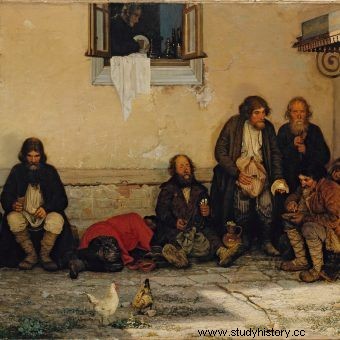
Dirt, stench and hunger. This, in short, is how the living conditions of the Russian peasantry under the tsarist regime can be defined. The illustration shows a fragment of a painting by Grigory Myasoyedov.
The enfranchisement reform of 1861 was supposed to be an antidote to the problems of the peasant masses. In practice, however, nothing has changed. The old order of tying the peasant to land and serfdom has replaced the new, but still serfdom system of taxes and financial obligations. The obligation of "redemption payments", which was spread over the next 49 years, was one of the reasons why the position of the Russian peasant in 1900, despite his theoretical freedom, was so much worse than a century earlier.
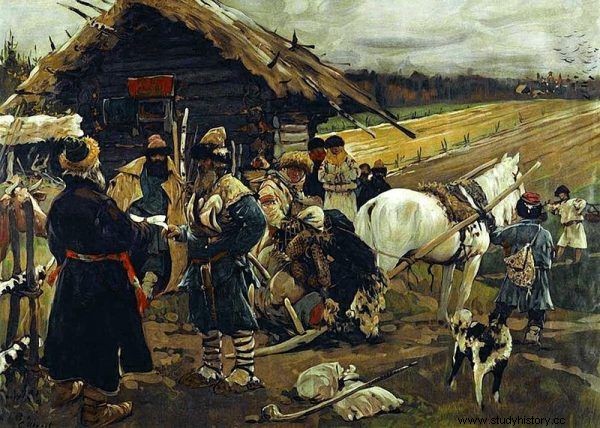
The painting by Sergei Ivanov "Peasants Leaving Their Lands". The poverty in the countryside forced some to migrate. However, the living conditions in the cities did not turn out to be better.
The rapid development of tsarist Russia at the turn of the 19th and 20th centuries in terms of demographics (the number of inhabitants increased from 30 to 92 million) and economic (the emergence of strong industrial centers, including the Donetsk Basin and the Bakink and St. Petersburg districts) created an opportunity for the peasant masses to improve their lives . And she, however, turned out to be illusory. When she came to the city, she joined the ranks of the working class that was emerging from the second half of the 19th century. Unfortunately, it often fell victim to the fledgling Russian capitalism. Farm slave labor has been replaced by factory slave labor.
Slave labor
In the period preceding the outbreak of the revolution of 1905, which gave rise to the systemic changes resulting from the October 1917 coup, the three-field system was still dominant in the Russian countryside. Therefore, the agricultural potential of the state was used to a small extent. Besides, the local peasant did not like technical novelties. When the cultivation of potatoes was introduced in the tsarist state in the 1830s, it coincided with the cholera epidemic, which resulted in the attribution of hellish powers to the new vegetable. As a result, still in 1875, the cultivation of potatoes occupied only 1.5% of the acreage.
In addition, there was a difficult climate in part of the country, which shortened the period of plant vegetation and holidays, the number of which at the turn of the 19th and 20th centuries fluctuated around 153 days. All these factors meant that when the period from June to August came, the Russian peasant often had to work eighteen hours a day in order to survive the whole year .
Those for whom there was no space in the countryside could always find employment as seasonal workers in the mines or in the construction of railways. However, their lives were not going to be easy there either. The working day, not regulated by any regulations, was usually 14 hours - there were also irregular payments reduced by the slightest offenses. Often, instead of money, they were rewarded with goods.
Dirt and stench
Difficult working conditions were not the only problem of the Russian masses. There were even tragic housing conditions. The Russian village was built of wood, which posed a constant threat of starting a fire. The log houses did not have chimneys and the smoke spread all over the house and was released through openings in the roof.
The host and his family lived in a room with animals, and the main equipment was a table and a bench. They slept on clay stoves, which took up about 1/4 of the room. In each of the huts there was a so-called a beautiful corner where at least one icon hung. It was the first place guests visited after crossing the threshold.
Hygiene? The Russian mob did not know. The floor in the cabin was often a combination of clay and mud. It was dirty. It is true that in some villages there were bathhouses, called bathhouses by the local people, but the peasants used them only once a week, most often on Saturdays. The other days, she just isn't wrong. Also, the peasants leaving the countryside for the benefit of the city could not count on better housing conditions. For many of them, the factory room was a standard, where a dozen or so people were housed.
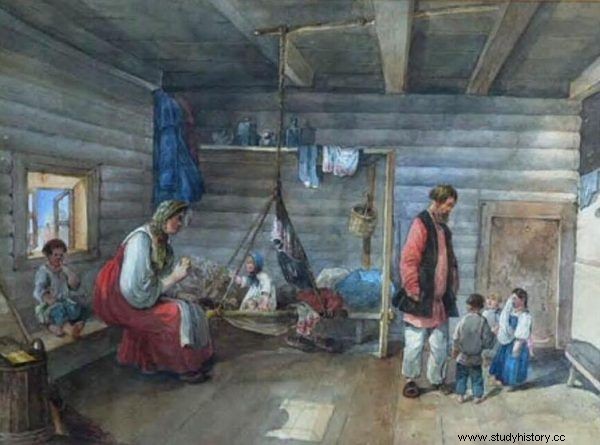
The hygienic conditions in which the mob lived in Tsarist Russia were appalling. The Russian peasant had to share one room with several family members and with cattle.
If they have nothing to eat, get them drunk
Long linen shirt tied at the waist and trousers. The miserable-looking Russian peasant was still hungry for that. He could only dream of meat. Apart from bread, he ate such "delicacies" as cabbage, peas and cucumbers. He had no problem with wanting though…
The lords and administrators of the lands did not spare their slave workers a large amount of alcohol. The vodka appearing on the table was supposed to be a cure for all the ills that torment the Russian masses. It was not only about intoxicating society - in tsarist Russia it was believed that alcohol can protect against diseases, especially cholera. In the 19th century, an average Russian citizen drank 1.3 liters of spirit a year, but the countryside drank much more .
Drunken, they became an easy breeding ground for fanatical leaders. It was enough to pull the appropriate string (religion, hidden public enemy, class conflict) and the masses changed, the mob was hard to control. At the end of the 19th century, alcoholism was increasingly noticed. Even the peasants themselves, who managed to make a "career", wanted to counteract him.
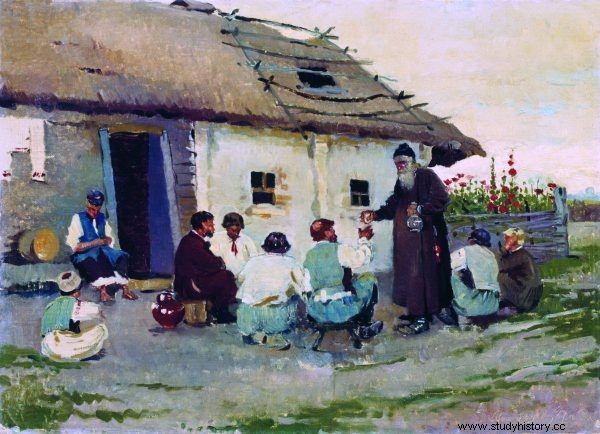
1.3 liters of spirit per year per head? It's only in tsarist Russia. The illustration shows a painting by Sergey Vinogradov "In the Tavern".
As Douglas Smith writes in his latest book, Rasputin. Faith, power and the decline of the Romanov dynasty ", coming from the village of Rasputin, was concerned about the abuse of alcohol by Russian society:" he often spoke out openly about the threat posed by vodka and talked about the need to fight the age-old Russian plague of drunkenness. "
The poorest suffer in the war
Although the revolution of 1905 was mainly social, directed against the oppression of industrialists, it brought about primarily political changes. The first Russian parliament was established and the activities of parties and associations were allowed. Political life was liberalizing, but the peasants were still dissatisfied.
Economic transformations, as well as the short-term warming of the climate that took place in tsarist Russia at the turn of the 19th and 20th centuries, gave the Russian masses hope that the situation would improve. It was especially visible in the countryside, where in the harvest years (1909, 1910) not only the crops increased, but also the number of household members. Unfortunately, with the outbreak of World War I, the old problems of the Russian masses returned. 15 million people, mostly peasants, were called to arms. This left its mark on agricultural production and its decline by 13%. Towns and villages were threatened with food shortages and rising prices. Petrograd and Moscow received only 1/3 of the needed food supplies. The masses were hungry and social life was moving towards anarchization.
The situation in the last years of tsarist Russia was like sitting on a powder keg; it only took one spark to make it explode. The Russian masses did not seek complicated answers to questions about the world, and the peasants did not know much about political matters beyond their own mir. They were looking for simple answers to the question:who is to blame for their bad situation. They found a rather irrational answer to this, as noted by Douglas Smith in Rasputin's latest biography:
The mysterious figures in the shadows were the real masters of the situation. Tiomnyje forces, "dark forces", as they were said, could mean something different to different people - Jews, Germans, Masons, Alexandra, Rasputin, and courtly camarilla - but it was taken on faith that they really ruled Russia .
Building an image of an internal enemy, a kind of scapegoat, in the end often led to social unrest. A perfect example is the anti-German riots that took place in Moscow in May 1915. Frenzy mob with the slogan "Beat the German!" he plundered and robbed shops, factories and private houses. The balance of the riots was 15 people killed and several hundred companies, houses set on fire .
The specter of the revolution
Furious and dissatisfied with their position, the masses of Russian society at the end of World War I demanded retaliation against the hated elites:factory owners, aristocrats, and even Tsar Nicholas II and his wife Alexander, who were influenced by fanatical mystics like Rasputin. And that was what the red banner revolutionaries were counting on. In one of the last letters of the tsarist favorite we read:
Our Lady's face has darkened and the ghost is haunted by anxiety in the silence of the night. This silence won't last long. This anger will be terrible. And where are we going to run? It is written:Stay awake, for you know neither the day nor the hour. This day has come to our country. There will be screams and blood. In the great darkness of these worries, I can now recognize nothing ... Countless people will perish. Many martyrs will give their lives. Brothers will kill brothers. The earth will shake. There will be famine and pestilence, people will see signs .
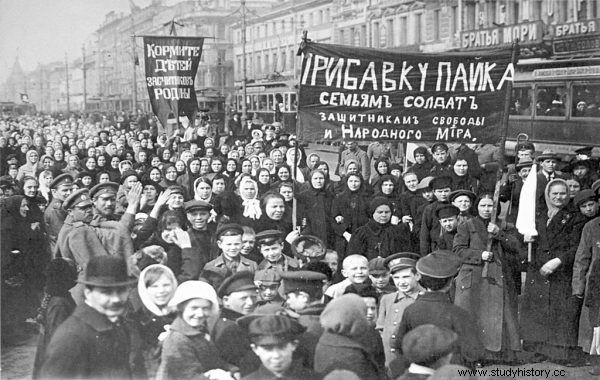
The beginning of the February 1917 revolution, which overthrew the tsarist regime, was considered to be the strike at the Putiłowski Works (pictured) - the largest metal and machine company in Russia. The lot of the workers, who often recruited from migrant peasants, turned out to be no better.
Douglas Smith in his latest book, Rasputin. Faith, Power and the Decline of the Romanov Dynasty ”poses an intriguing question here:could Rasputin have foreseen the specter of the impending revolution? As an excellent observer of the masses he descended from and manipulated like no one else, was he aware of the fact that the mob would soon have new charismatic leaders? Equally, and maybe even more fanatical? So much so that in 1917 tsarist Russia ended her life in a sea of blood .
Bibliography:
- L. Bazylow, History of Russia , Warsaw 2010.
- S. Fitzpatric, The Russian Revolution , Warsaw 2017.
- B. Góralski, The Earth's climate mechanism and the social effects of climate change , 2013 [online access:3/11/2018].
- Russian mentality. Dictionary , edited by A. De Lazari, Katowice 1995.
- R. Pipes, Tsar Russia , Warsaw 2006.
- J. Ratuszniak, The image of St. Nicholas' Russia in the diary of Amelia Lyons (1849 - 1854) , Lublin 2013.
- D. Smith, Rasputin. Faith, power and the decline of the Romanov dynasty , Krakow 2018.
- A. Solzhenitsyn, Russia in decline , Warsaw 1999.
